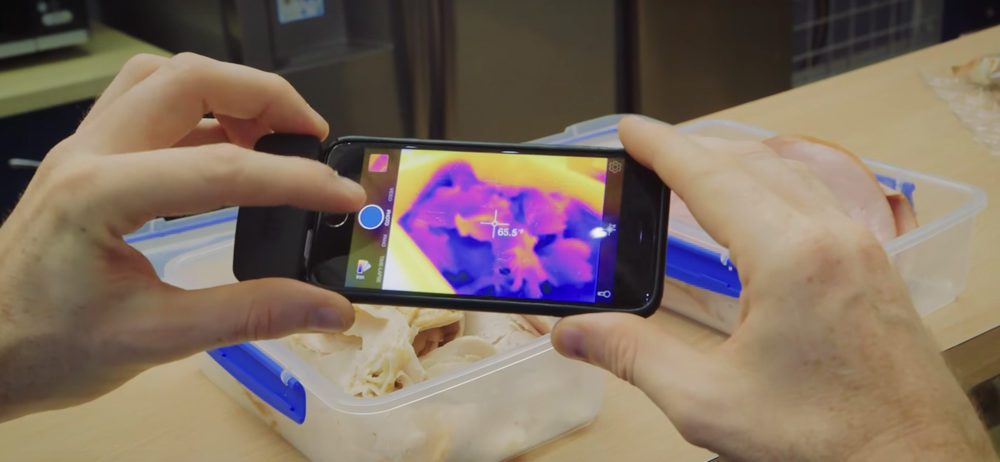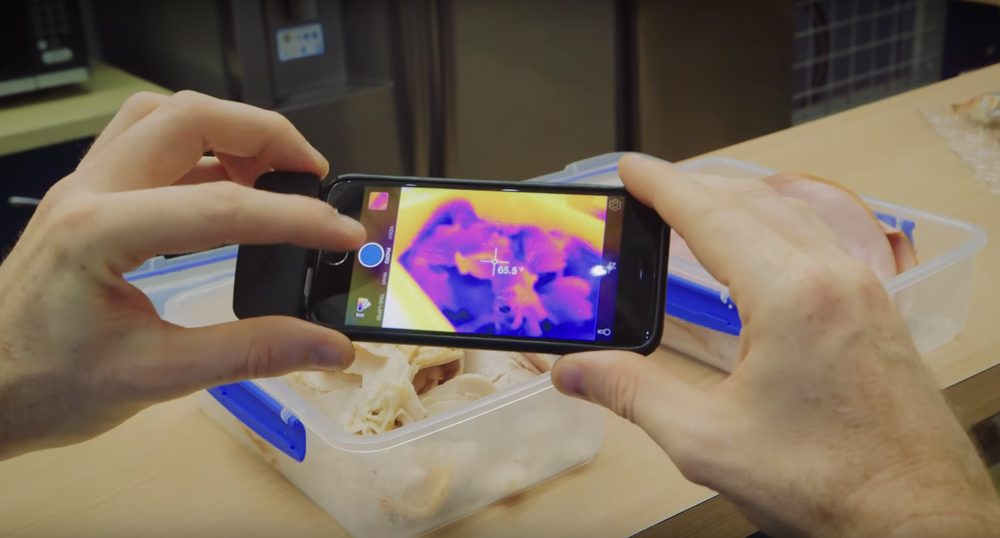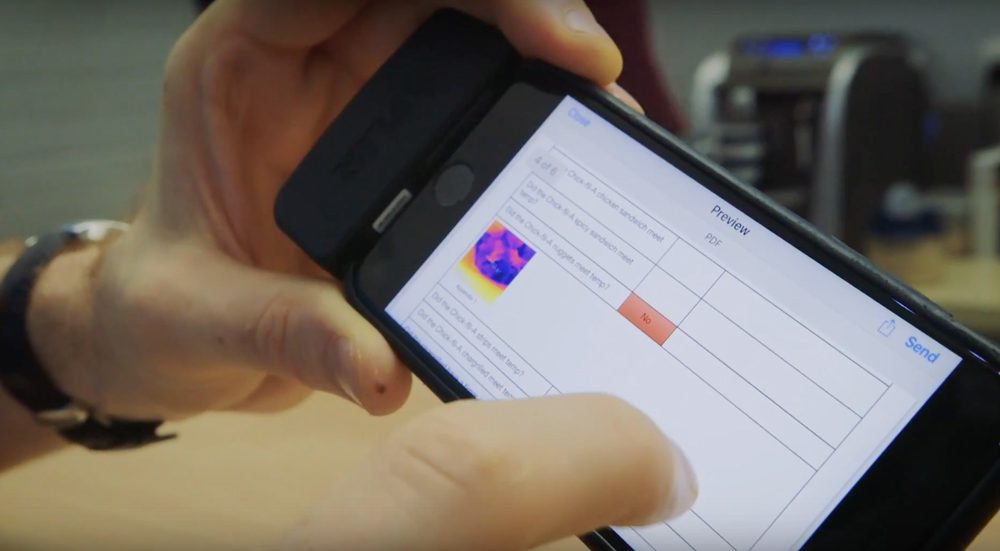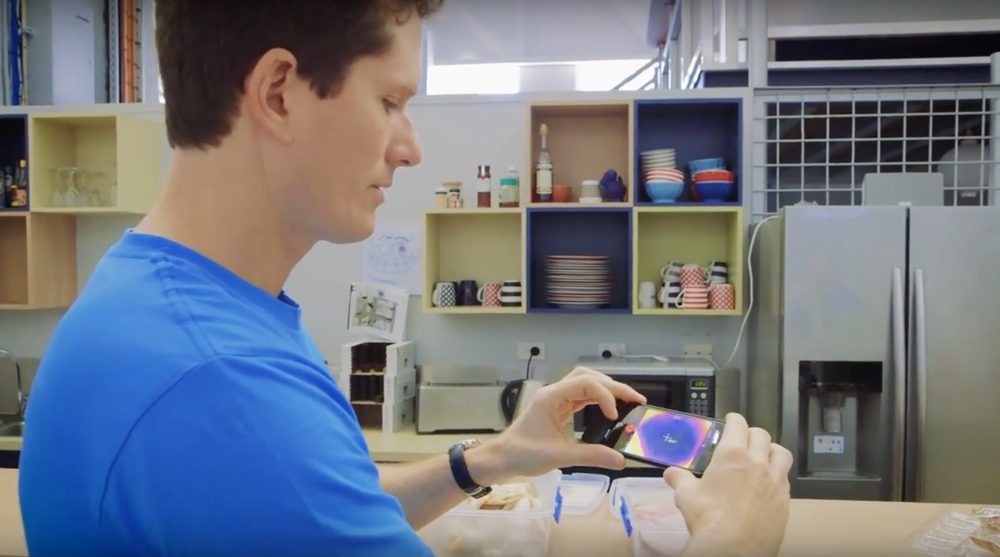A review of FLIR – How thermal imaging can change food inspections
Industry Trends | By | 25 Jan 2016 | 3 minute read

FLIR has recently made a handheld camera attachment available for iPhones, which anyone can pick up for about $US200.
FLIR is a company that has been known to create the high-end search and rescue cameras often used under helicopters. Firefighters also use FLIR cameras to identify heat when visibility is poor.
But now thermal imaging is affordable for everyone. The FLIR One infrared camera can sense surface temperature variations, and display them in a range of colour palettes from high contrast black and white through to rainbow, arctic, hot/cold and iron. The camera plugs into your iPhone lightning adapter at the bottom of the phone and is charged via a USB cable.
Temperature Ranges
The FLIR One camera provides a scene temperature range from -4°F to 248°F, making it very handy to monitor if your food in the fridge or on the bench is the correct temperature. It has the ability to detect temperature sensitivities as small as 0.18°F or 0.1°C. You can also choose to display your temperature reading in fahrenheit or celsius.
This new device is particularly interesting for SafetyCulture customers who use iAuditor to conduct food inspections.
Thermal imaging and food safety
With the risks associated with food poisoning well documented, it is essential to control the temperature of perishable goods. In Hawaii 2,150 food outlets were recently inspected and as regulators increase enforcement efforts across the world, a low cost device such as the FLIR camera can provide business operators with some valuable assistance.
Restaurants in New York using iAuditor to conduct three walk through inspections a day can move from a New York City food standard B rating to an A rating. This can be worth up to $500,000 a year in additional revenue. Now they can take temperature readings throughout the day on hot and cold foot lines.
The FLIR thermal imaging cameras that you can attach to your iPhone gives you an instant temperature measurement, simply by aiming your camera at the food you’re inspecting.
The device can measure the temperature of equipment, refrigerated products and monitoring perishable goods left out in bain-maries.
Monitor your equipment
Thermal imaging is an essential tool for quality insurance in the food industry. Besides improving food quality and safety, a device like this can ensure your equipment is running efficiently. You can monitor if a heating element on your oven is failing to produce enough heat so you don’t waste food.
Auditing using the FLIR camera
When you’re using iAuditor, you can add photos from your FLIR photos folder straight into your inspection report. The temperature reading is stamped onto the image, capturing a record that is available for review later.
How to use the FLIR Thermal Camera with iAuditor:
- Start conducting your food inspection in iAuditor
- Open the FLIR app to capture take image of the food or surface you wish to measure
- Return to iAuditor and add the image to your audit on the spot
The benefits of capturing temperature on the spot:
- Check whether perishable goods sitting out are at safe temperatures to serve
- Seals on microwaves or refrigeration can be checked for leaks
- Monitoring temperature zones in refrigerator and freezer compartments
- Inspect ovens are operating at the correct temperature
SafetyCulture verdict on FLIR One
Is it worth buying? Absolutely. It takes the guesswork out so you can ensure your equipment such as fridges, freezers, seals and ovens are operating efficiently. Ensuring perishable goods sitting in a bain-marie are at a safe serving temperatures is essential when running a commercial food operation.
Follow our YouTube channel for more product reviews.
Download free food inspection templates
Download Food Temperatures Checklist
Download Daily Fridge/Freezer and Hot Food Temperature Checklist
Download these via iAuditor on your device.
Important Notice
The information contained in this article is general in nature and you should consider whether the information is appropriate to your specific needs. Legal and other matters referred to in this article are based on our interpretation of laws existing at the time and should not be relied on in place of professional advice. We are not responsible for the content of any site owned by a third party that may be linked to this article. SafetyCulture disclaims all liability (except for any liability which by law cannot be excluded) for any error, inaccuracy, or omission from the information contained in this article, any site linked to this article, and any loss or damage suffered by any person directly or indirectly through relying on this information.








